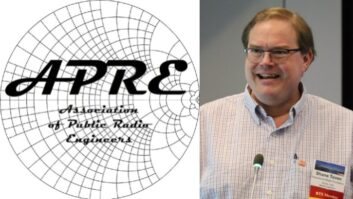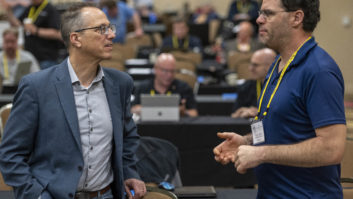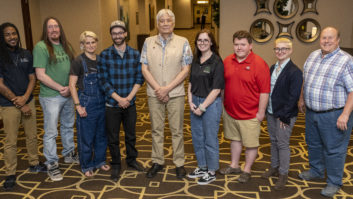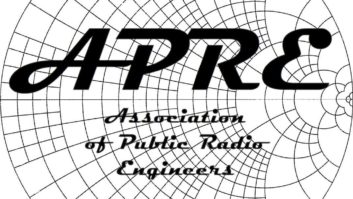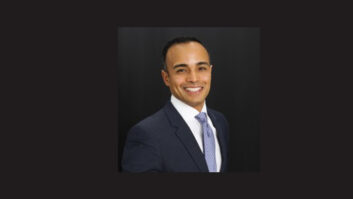
Among the eight people recognized by the Association of Public Radio Engineers as founding board members were, from left, Paxton Durham, Rich Parker and Ralph Hogan.
Credit: Photo by Jim Peck Some 85 engineers and other station employees attended this year’s Public Radio Engineering Conference in April. That compares to about 65 last year.
The Association of Public Radio Engineers organizes the annual event. Members pride themselves on offering practical and forward-thinking technical information that can be useful to both non-commercial and commercial engineers.
This year’s conference was held at Caesar’s Palace in Las Vegas prior to the spring NAB Show. Among the highlights of the 14th annual PREC:
APRE HAS NEW OFFICERS
The Association of Public Radio Engineers voted in a new slate of officers in May. The group has been around long enough that the makeup of the entire board has now turned over.
The all-volunteer APRE launched in 2006 and incorporated as a nonprofit organization in 2008. APRE launched as an educational member organization for non-commercial radio engineers and other technical personnel. When the group formed, the premise was to be open to technical personnel of any public radio facility. At the Public Radio Engineering Conference, the organization changed its bylaws to allow retired public radio personnel to remain members.
Also, as several of its founding members rotate off the board, APRE wanted to honor them and other former founding board members. Board service is limited to two consecutive three-year terms.
Eight engineers were recognized with founding APRE board member emeritus plaques: Jan Andrews, former senior engineer, NPR Labs; Gordon Carter, former chief engineer of WFMT(FM), Chicago; Paxton Durham, chief engineer for WVTF(FM), Roanoke, Va.; Ralph Hogan, director of engineering for KJZZ(FM), Tempe, Ariz. who was APRE’s founding president; Roger Karwoski, former assistant manager and director of engineering for KBIA(FM), Columbia, Mo.; John Holt, chief engineer, WAMU(FM), Washington; Rich Parker, former director of engineering for Vermont Public Radio and now with Coast Alaska; and Doug Vernier, president and owner of V-Soft Communications.
Those not in attendance received their plaques via mail.
At a subsequent board meeting in May, APRE elected a new slate of executive committee members for 2014–15:
Jobie Sprinkle, director of engineering/IT, WFAE(FM), Charlotte, N.C., is now president of APRE, moving up from vice president. Paxton Durham, one of the eight founding board members, becomes immediate past president and remains on the executive committee.
David Antoine, chief engineer, WBGO(FM), Newark, N.J., is now vice president; Shane Toven remains treasurer. Toven is former director of engineering for Wyoming Public Media, now technology advisor; he is the new editor of Radio magazine.
Dan Houg, chief engineer, KAXE(FM), Grand Rapids, Minn., becomes secretary of APRE.
Joining the board for three-year terms are Vermont Public Radio Director of Operations Victoria St. John and NPR Labs Technical Researcher Alice Goldfarb. They join other board members: Robert Carroll, chief engineer, WWNO(FM), New Orleans; Jonathan Clark, sales manager, Shively Labs; Dan Mansergh, director of radio engineering and media technology, KQED(FM), San Francisco; and Bruce Wahl, senior solutions architect, NPR Distribution.
RIPR USES FURNACE TO HEAT SATELLITE DISH
Rhode Island Public Radio uses an unconventional method of melting snow off its 12.5-foot satellite dish.

Rhode Island Public Radio’s Aaron Read discussed a way to use hot air from a furnace to melt snow off a satellite dish.
Credit: Photo by Jim Peck Most stations have their dishes at their studios, where it’s easy to send someone outside with a broom to brush the snow out of the dish. However RIPR’s studios are in downtown Providence, while the satellite dish is about three miles away in North Providence at its old AM site. The dish also sits on the edge of an embankment, so climbing up to clean out the dish is hard, according to RIPR Director of Engineering Aaron Read.
“Dish heaters can get overwhelmed by heavy, wet snow,” Read told PREC attendees. He needed a different solution.
There is a large forced-air furnace in the shelter building near the dish and Read wanted to use that hot air to melt the snow in the satellite dish. He rigged up insulated vent tubing and fans as well as furnace ductwork to the shelter building.
The ductwork goes to the main hot air furnace output inside the building. Now, that hot air is blown into the cavity between the satellite dish and the heavy-duty vinyl dish cover, which was fabricated by Walton De-Ice.
The retrofit is working and kept the dish clear enough this winter for RIPR to maintain its satellite downlink with NPR. The project cost about $2,000 as opposed to a projected $16,000 for a full retrofit, he said.
Read hopes eventually to replace the dryer tubing with PVC pipe to reduce heat loss.
NPR MOVE SPURRED SEVERAL CHANGES
Employees of National Public Radio’s Distribution Division are still ticking various items off their punch list a year after their move to the new building on North Capitol Street in Washington.
And that’s perfectly all right, said Mark Murphy, director of engineering for NPR Distribution, which manages the Public Radio Satellite System. The move was a success for NPR Distribution, he said.
Murphy told attendees that PRSS is going through several transitions. For example, the way the uplink equipment is laid out has changed because employees were able to use fiber optics to carry the signal from the roof antenna on down to the Network Operations Center.
NPR Distribution also used the opportunity of new space to shift from analog to digital audio routing, along with the rest of the company. “All audio in this building is now digital,” said Murphy.
“The move gave us an opportunity to start fresh and use the latest equipment available. Today, we’re in a much better place than if we had tried to do the same modernization without moving.”
What has he learned through the move process? “It’s worth it to do to things systematically. We managed to do that but the temptation to cut corners and rush gets stronger” as move date approaches. He recommends that project managers fight that urge, and have the discipline to carry out your plan, rather than just responding to the crisis of the day. Keeping up with documentation is important also.
Murphy is one of several NPR employees who spoke at PREC about the move.
NPR LABS UPDATE
NPR Labs has several ongoing projects; one of those is the Department of Homeland Security alerting project for the deaf and hard-of hearing. The testing, funded by FEMA and managed by the Department of Homeland Security, involves development of an accessible FM RDS receiver to be used in an emergency alerting demonstration program in the Gulf Coast region.
The work involves testing broadcast emergency texts with some 250 deaf and/or hard-of-hearing volunteers through 26 public stations in Alabama, Florida, Louisiana, Mississippi and Texas.
NPR Labs Director Rich Rarey said the Labs is set to begin testing with the volunteers on this project. One engineer, Sam Brown, has driven some 1,000 miles, making sure all the equipment is ready.
NPR Labs is also working with the National Radio Systems Committee on studies to determine compatibility of FM single-sideband transmissions and a study on AM modulation-dependent carrier level transmissions. It is also updating its HD Radio power calculator.

Recipients of APRE’s 2014 Engineering Achievement Award NPR’s Bud Aiello, left, and consulting engineer Gray Frierson Haertig.
Credit: Photo by Jim Peck Rarey was recently promoted, following the retirement of Mike Starling. John Kean is senior technologist, Alice Goldfarb is technical researcher, and Paul Littleton is technical research assistant for the Labs. Dr. Ellyn Sheffield is a consulting partner.
AIELLO, HAERTIG HONORED
The Association of Public Radio Engineers chose two recipients for its 2014 Engineering Achievement Award: Bud Aiello, director of engineering technology at NPR and Gray Frierson Haertig, owner and principal engineer of Gray Frierson Haertig & Associates.
Award recipients are nominated by their peers. Aiello’s nomination noted his work on NPR’s new technical facility, where he served as the architect for the overall systems. “From the early days of designing, to climbing in the construction hole to check the contractor’s welds of the grounding grid, to wrestling into submission multiple vendors,” Bud’s work proved to be invaluable, the group said.
Aiello’s fellow engineers wrote on the nomination form that Aiello “has a keen eye for detail, uncanny instincts for problem-solving, and is a gifted arbiter of where to take advantage of new technologies and where to avoid risks with designs he has reason to doubt will bear the tests of time.”
Aiello said he spent the first half of his career in commercial radio and thanked former NPR Vice President/Chief Technology Officer Mike Starling for hiring him from WAVA(AM/FM), Arlington, Va. Aiello called the NPR studio builds — the recent one on North Capitol Street, and the prior one at the old Massachusetts Avenue building — “a lot of fun.”
The nomination form submitted for Gray Haertig pointed to his “prolific presence” on the Pubtech listserv that “has educated and mentored a significant number of engineers still on the steep side of the learning curve of radio engineering.” Also noted was his work with “numerous new non-commercial radio facilities including those stations serving indigenous populations” for which he provided RF engineering services that were needed to build, remodel or improve.
Haertig estimated he has completed FCC filings for 300 to 350 stations non-commercial stations over the years. He credited Ben Dawson, now managing partner and senior engineer at Hatfield & Dawson Consulting Engineers, for taking him “under his wing” when Haertig was in high school. When Haertig graduated, he got his FCC First Class license and Dawson made him chief engineer of a new station in Portland, Ore.
“I made lots of mistakes. That’s how you learn,” said Haertig, but he also learned “not to make mistakes in front of a client.” Portland is where Haertig’s engineering consulting firm is based.
The awards were presented at the annual APRE/PREC Engineering Awards Dinner.





